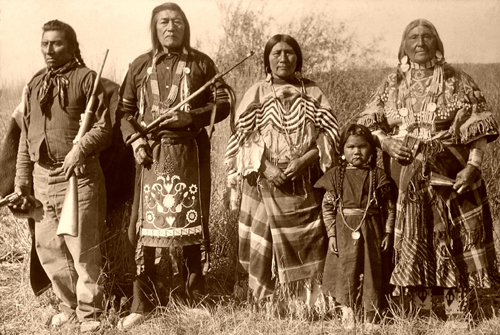
| Powwow | Home Life |
| Reservations | Tribes |
| Resources |
"It shall be the policy of the United States to protect and preserve for
American Indians their inherent right of freedom to believe, express and
exercise the traditional religions of the American Indian, Eskimo, Aleut, and
Native Hawaiians, including but not limited to access to sites, use and
possession of sacred objects, and the freedom to worship through ceremonials and
traditional rites.

A Powwow, was originally to celebrate the seasonal renewal of new life. People
would congregate to sing, dance, renew old friendships and form new ones.
Powwows had religious significance as opportunities to hold a naming, now
usually conducted in the privacy of a family gathering, and honoring ceremonies.
In the Dakota/Lakota tradition, the celebration was also a prayer to Wakantanka.
Powwows are still very much a part of the lives of many Native Americans around
the state and country and are held every weekend, often at several locations
during peak periods, from June until September. Many families "go on the
circuit', camp out and enjoy the traditional activities. Competitive singing and
dancing, relatively recent changes, are often featured.
The circle, an important symbol to Native American people, is used extensively in powwows. The dancers are in the center, the drums and the audience circle around them and the concessions surround the gathering. The powwow brings the circle of people closer to family, friends and the comfort and vitality of their culture.
You can visit any of the Indian reservations, but there may be little for you to
see. Most Indian families live in homes that are not very different from any
other houses in the USA. On the wealthier reservations, the natives live in nice
modern houses or on large ranches. On the poorer reservations, the natives live
in small older houses or trailers. Very few natives live in the traditional
dwellings of their ancestors. The Indian pueblos in New Mexico and Arizona are
the rare exception where some of the natives still live in the ancient adobe
communal buildings of their ancestors.
Most Indian families enjoy their privacy as much as you do in your own home.
They may not appreciate bunches of tourists coming to their homes on the
reservation to stare at them and to photograph them. On some reservations, there
are signs stating that all outside visitors must register at the tribal office
or that no photography is permitted on the reservation. Some tribes have built
special visitor centers, museums, stores or casinos on their reservations, and
they invite tourists to come to visit these places.

The Indian reservation is the spiritual and cultural center for all members of
the tribe including those living far from it. The native language, the cultural
traditions and the religious ceremonies are typically preserved by the tribal
members living on the reservation. Unfortunately, you will not get much chance
to experience Indian culture by visiting the Indian casino or by purchasing
cheap cigarettes in the reservation store. Most of the authentic religious
ceremonies and cultural events are not open to the public.
One way of experiencing authentic Native American culture is by visiting one of the Indian cultural centers or Indian museums
There are over 300 different Native American Tribes in North America. If you would like to see a list of the federally recognized tribes click on the arrowhead below.
http://www.usatourist.com/english/inside/indians2.html
http://www.bluecloud.org/dakota.html
http://www.artnatam.com/tribes.html